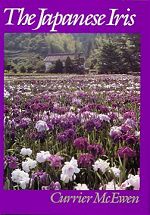
|
The
Japanese Iris Reviewed by A. R. Ferguson There are some books that are immediately attractive. The Japanese Iris is one such book. It is not just that it handles well and is handsomely produced, that the drawings are good, that the colour plates are mostly magnificent, or, even, that it is well written. It is more that the author, Currier McEwen seems such an agreeable man who would, I imagine, be good company and good fun. His personality comes through in his writing. He is not, however, too amiable or unfailingly kind and at times a crotchety note does emerge. The chapter on insect and other pests concludes: "Finally we come to the problem of the garden visitor who does not know the rules of good garden manners. One should not hesitate to ask that handbags, camera bags and the like not be carried into the rows ... Fortunately today's fashion styles do not encourage the visitor to wear the wide loose skirts common some years ago. One can still remember with dismay the havoc caused when a visitor in one of the "ballerina skirts" turned quickly. The billowing, twirling skirt could take off a dozen blossoms. With fashion's trend to narrower skirts and, especially slacks, the problem of inappropriate dress has rarely been a danger in recent years and the main hazard continues to be the dangling bag, with as runners up, unsupervised small children and unleashed dogs." Clearly, you are expected to behave when you visit Dr Currier. The author was for many years Dean of the School of Medicine at New York University. Now, almost 90, he writes well with easy authority and ready wit. His text is straightforward, clean and economical and his definitions and choice of words often most apt — "nicely organised, compact form", "single flower of flaring, rather tailored form", "ruffled white form and dark blue-violet edging". There is a good glossary of terms and it is a delight to find a horticultural book that is properly referenced, with citations to specific comments in the text and allowing those interested to read more widely. One of the most appealing features of this book is its strong emphasis on the history of the Japanese iris and its place in Japanese culture. This allows us to understand better the aims of the early Japanese breeders. For example, a very special use of the Higo iris was in the ritual of the Act. A well-grown potted iris of suitable type was taken inside and placed in front of a golden screen. The follower of the ritual meditated as the flower slowly opened and changed hour by hour. Against such a golden background flowers of pure white or single colours were considered to be more beautiful than those with pale colours or patterns. A single magnificent bloom was more suitable than a branched inflorescence. Now that Higo irises are more widely grown outside, the requirements of breeders have changed. There is also an account of the history of the Japanese iris in the United States. This will probably be of less interest to readers in this country but, together with an appendix, it describes how the Japanese iris was taken from its homeland and distributed throughout the world. I found the chapters dealing with the classification of the Japanese iris to be rather less satisfactory. I would have liked fuller descriptions of the most closely related species. Furthermore, in the first chapter, that dealing with the history of the Japanese iris in japan, we are told how Japanese irises were classified as Edo, Higo or Ise types, according to their geographic origin but the distinguishing features of the flowers of each type are not described until the third chapter. The classification of modern hybrids is summarised very clearly in the fourth chapter. The chapters covering cultivation, use in the garden, pests and diseases seem comprehensive and contain much common sense. Throughout there is stress on the value of Japanese irises as garden plants and this is emphasised by the thirty two colour plates. The photographs are almost all excellent technically and the blooms displayed extraordinarily beautiful. Dr Currier has devoted himself to the Japanese iris for more than thirty years and has gained much success as a hybridiser. Thus he has four times won the Payne Award, the highest Award of the American Iris Society. About a quarter of The Japanese Iris is devoted to an authoritative account of hybridizing, the handling of seeds and seedlings, the evaluation of seedlings and the registration of cultivars. These chapters may be of little practical value to the home gardener but they are definitely worth reading, especially the appraisal of what makes a "good" garden plant. I enjoyed The Japanese Iris. I doubt that I would ever be inspired to attempt breeding but it has encouraged me to contemplate making another bog garden, this time for Japanese irises. Horticulture in New Zealand: Journal of the Royal New Zealand Institute of Horticulture 1991 2(1): 34-35 Web Notes: Currier McEwen died on June 23, 2003-shortly after his 101st birthday. |
Home | Journal
| Newsletter | Conferences
Awards | Join
RNZIH | RNZIH Directory | Links
© 2000–2024 Royal New Zealand Institute of Horticulture
Last updated: March 1, 2021

 BOOK
REVIEWS
BOOK
REVIEWS